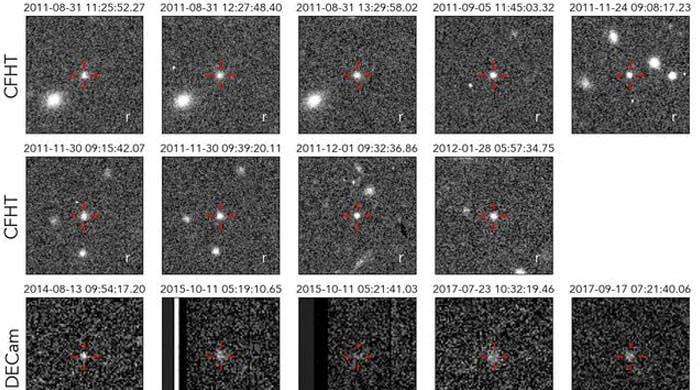Washington: Scientists discovered a new strange object far beyond Neptune, in one of the coldest and most distant parts of our solar system.
The object, named 2017 of 2017, is frozen, far away and perhaps large enough to be called a dwarf planet. It takes about 25,000 years to go around the sun once.
The researchers say that it is one of the most distant things that we have ever seen in space – and this could be a clue that many other hidden worlds are still waiting to be found.
The researchers called it one of the most distant visible objects from our solar system and said that its existence indicates that a large expanse of space beyond the most external Neptune planet – and a region called Kuiper belt – may not be deserted, as a long reflection. The Kuiper belt is populated by many frozen bodies.
The object falls into a category called trans-neptunian objects that orbit the sun at a distance beyond that of Neptune.
The researchers said that 2017 of 2017 had been identified in observations by telescopes in Chile and Hawaii extending over seven years.
“It is potentially large enough to be considered a dwarf planet. His orbit is very wide and eccentric, which means that he has experienced an interesting orbital migration path in the past, “said astrophysicist Sihao Cheng of the Institute for advanced studies in Princeton, New Jersey, who led the study at the University of Primorton.
Its size is estimated a little smaller than Ceres, which is the smallest of the five recognized dwarf planets in the solar system and has a diameter of approximately 590 miles (950 km). Pluto, the largest of these dwarf planets, has a diameter of approximately 1,477 miles (2,377 km).
The 2017 mass of 2017 is estimated at around 20,000 times smaller than the earth and 50 times smaller than that of Pluto.
“We do not yet know the form. Unfortunately, it is too far and it is a little difficult to solve it with telescopes,” said Cheng. “Its composition is still completely unknown, but probably similar to other frozen bodies.”
The discovery was announced by the Minor Planet Center of the International Astronomical Union, an international organization of astronomers, and detailed in a study published on the Arxiv free research site. The study has not yet been examined by peers.
The orbital distance from the earth of the sun is called astronomical unit. 2017 of201 is currently located at a distance of 90.5 astronomical sun units – which means 90.5 times with regard to earth.
But at its point farther from its orbit, 2017 of 201 is more than 1,600 astronomical units of the sun, while the point closest to its orbit is around 45 astronomical units. This means that it is sometimes closer to the sun than Pluto, whose orbital distance varies from 30 to 49 astronomical units when it travels an elliptical path around the sun.
Researchers suspect that the extreme orbit of 2017 of 2017 of 2017 can have been caused by a close meeting a long time ago with the gravitational influence of a giant planet.
“We still do not know much about the solar system far, because it is currently difficult to see things directly beyond 150 astronomical units,” said Cheng. “The presence of this only object suggests that there could still be a hundred objects with an orbit and a similar size. They are simply too far to be detectable at the moment.”
The five dwarf planets recognized by the international astronomical union are, in order of distance from the sun: Ceres, which is the greatest object of the asteroid belt between Mars and Jupiter; Then Pluto, Haumea, Makemake and Eris, who all have orbit beyond Neptune.
The organization defines a planet and a dwarf planet differently. A planet must orbit its host star – in our case, the sun – and must be mainly round and large enough for its gravitational resistance to eliminate all other objects of similar size near its orbit. A dwarf planet must orbit the sun and be mainly round, but it has not erased its orbit from other objects.
Cheng said that the 2017 discovery of 2017 has implications for hypotheses involving the potential existence of a ninth planet in our solar system, baptized Planet X or Planet Nine.
Indeed, the 2017 orbit of 2017 does not follow the model presented by other known trans-neptunian objects, which tend to regroup. Some scientists had hypothesized that such a group was caused by the gravity of a planet still discovered.
“The existence of 2017 of 2017 as an aberrant value to such a regrouping could potentially contest this hypothesis,” said Cheng.




